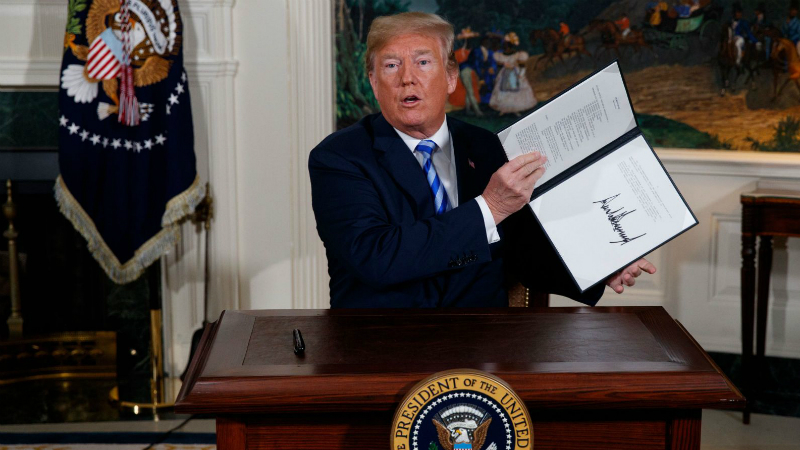Trump’s New Iran Policy, Three Days In
President Trump finally announced on Tuesday that the United States would withdraw from the Joint Comprehensive Plan of Action, the multilateral agreement constraining Iran’s nuclear program in exchange for sanctions relief.

Published by The Lawfare Institute
in Cooperation With

President Trump finally announced on Tuesday that the United States would withdraw from the Joint Comprehensive Plan of Action, the multilateral agreement constraining Iran’s nuclear program in exchange for sanctions relief. In the days before Trump’s statement, it had become clear that Trump would not defer withdrawal again, as he had last fall, and European diplomats urging Trump to remain in the deal—including French President Emmanuel Macron, German Chancellor Angela Merkel, and British Foreign Minister Boris Johnson, who each came to Washington to make the case for the agreement—sounded resigned after their meetings with the president. The U.S. withdrawal from the agreement comes despite the fact that, by all accounts, it has successfully reined in Iran’s nuclear program, extending the breakout time Iran would need to develop a bomb to more than a year. The International Atomic Energy Agency, the organization responsible for monitoring Iran’s compliance with the agreement, has consistently found that Iran has abided by the deal since it entered force in 2016.
The Iran deal is not dead—not entirely. The other parties to the agreement—Britain, France, Germany, China, and Russia—will continue to nurse it along and prevent its complete collapse. After Trump’s announcement on Tuesday, the British, French, and German governments issued a joint statement reaffirming their support for the deal. But the U.S. withdrawal is a severe blow to the sustainability of the agreement.
The most immediate consequence of Trump’s decision will be the gradual reimposition of U.S. sanctions on Iran that were previously waived under the deal. As Elena Chachko wrote for Lawfare earlier this week, these sanctions won’t have much bite—the United States does not trade with Iran and most Iranians that will be targeted have likely already moved their assets out of reach of the United States. The bigger question is how far the United States will go to enforce secondary sanctions on businesses that trade with Iran, including European companies that have signed deals with Iran since the implementation of the JCPOA. How the United States imposes and enforces sanctions could set up a showdown with the United States’ European partners who have said they will continue to abide by the agreement. U.S. officials are now urging European companies to “wind down” their business with Iran, but European countries are considering options to protect their companies from U.S. sanctions, including “a so-called EU ‘blocking regulation,’ which would prohibit compliance with U.S. secondary Iran sanctions.” The Weekly Standard reported yesterday that the Trump administration and members of Congress are considering a proposal from the Foundation of Defense of Democracies’ Richard Goldberg that involves threatening European countries with protectionist trade tariffs on steel and aluminum if Europe tries to shield its companies’ business with Iran.
Trump suggested in his statement on Tuesday that the goal of withdrawing from the JCPOA is to eventually secure a new agreement that goes further than the current deal. “The fact is they [the Iranian government] are going to want to make a new and lasting deal, one that benefits all of Iran and the Iranian people,” Trump said on Tuesday. “When they do, I am ready, willing, and able.” What that might entail exactly is unclear, but administration officials have often expressed frustration that Iran retained any enrichment capacity and that the deal did not include constraints on Iran’s ballistic missile development. The Obama administration, when the JCPOA was negotiated, argued that eliminating Iran’s civil nuclear research and its missile program were unrealistic concessions that the Iranian regime would not accept—and that was when the United States had the cooperation of its negotiating partners and an international sanctions campaign on its side. The Trump administration seems to think it can get more concessions with less leverage. How? There is no plan. The United States is now lurching toward a direct confrontation with Iran with an ad hoc strategy.
Don’t take my word for it. That comes straight from the State Department. In a background briefing on Tuesday, a befuddled reporter pressed two State officials for how the United States would work with its partners to constrain Iran’s nuclear program now that the White House had shot down the supplementary agreement being worked on by France, Germany, and Britain. The State Department’s response: “We did not talk about a Plan B in our discussions because we were focused on negotiating a supplemental agreement, so we did not—we did not talk about Plan B.” The administration does not have a plan for how to make the sanctions, which they valued more than the agreement and their relations with Europe, work. It also does not have a plan for how else to pressure Iran. The Washington Free Beacon reports that officials are now mulling a proposal from the Security Studies Group—a small think tank founded by veterans of Frank Gaffney’s Center for Security Policy, a hotbed of paranoid and misinformed policy—that advocates the Trump administration adopt a clear policy of regime change in Iran, including support for groups trying to destabilize the government. "U.S. policy toward Iran currently does not publicly articulate two components vital to success: That a new birth of liberty based in self-determination for the Iranian people should be official policy; and that military action should be anticipated if other measures fail,” the paper states.
The lack of preparation for a moment the Trump administration has signaled since last October has many experts concerned. “Trump’s move was a chest-thumping political decision, not a clearly articulated strategy,” David Ignatius wrote yesterday in the Washington Post. “The path ahead begins with the need for a clear policy toward the future of Iran—and not the vague notion of regime change that’s bandied about. Whatever Trump may fantasize, intelligence professionals say this is not a pre-revolutionary moment in Iran. The economy is weak but not crumbling; the population is restless but not marching in the streets; the regime has fissures, but the military and security services appear solid.” Hussein Ibish notes that Trump’s promises to pressure Iran in the Middle East do not match up with his apparent aversion to hitting Iranian sites in the recent punitive missile strikes in response to the Assad regime’s use of chemical weapons and his declared intent to pull U.S. troops out of Eastern Syria and lean more heavily on the Gulf states to project force. Withdrawing from the Iran deal runs U.S. policy off the rails, and now it’s hard to tell where it might roll.
It’s not in Iran’s interest to provoke a conflict with the United States, but escalation happens in unpredictable ways. It seems noteworthy that, just hours after Trump’s announcement, a new round of sparring broke out along the Israeli-Syrian border. On Tuesday, Israeli defense officials identified what they reported were new Iranian maneuvers near the Golan Heights; residents of the Golan were ordered to seek shelter and Israeli jets carried out strikes. The following night, Iranian forces in Syria fired 20 missiles toward the border—some never reached the Golan Heights and others were intercepted by Israel’s Iron Dome missile-defense system. Though ineffective, it was the first time Iranian forces had directly fired on Israeli territory. Israel responded on Thursday with strikes on Iranian targets across Syria that Israeli Defense Minister Avigdor Lieberman claims destroyed “nearly all” of Iran’s military supplies in the country. Israel’s strike on Thursday also set a precedent: It was the first time Israeli officials have publicly acknowledged striking targets in Syria.
An Iranian response to Israel’s strikes on Iranian targets in Syria has been a long time coming, and many expected it sooner. After an Israeli strike on the Tiyas airbase last month—the second time Israel had attacked Iranian drones based there—Brookings’ Dror Michman and Yael Mizrahi-Arnaud wrote that an Iranian counterattack via missile salvo was “likely in the works.” But Iran took its time, until after Tuesday’s announcement. By withdrawing from the JCPOA, Trump may have lifted a brake on Israeli-Iranian confrontation that, if it escalates, could threaten to pull in the United States. If it does, Iran can act through its network of proxies throughout the region: firing rockets into Israel from South Lebanon, attacking U.S. troops in Iraq, launching missiles at U.S. ships off the coast of Yemen or harassing them with swift boats in the Gulf. Israeli officials said today that this round of fighting appears to have subsided, but there are no guarantees about the next round of strikes and reprisals, or the one after. In each new exchange, the odds of miscalculation and escalation will be present, and will only get worse as the JCPOA’s faltering weakens Iranian President Hassan Rouhani, empowers the Iranian hardliners who oppose him, and emboldens Israeli policy to confront Iran.





